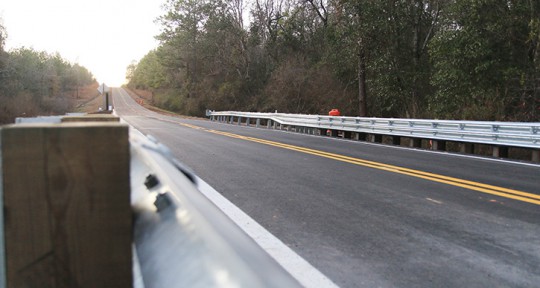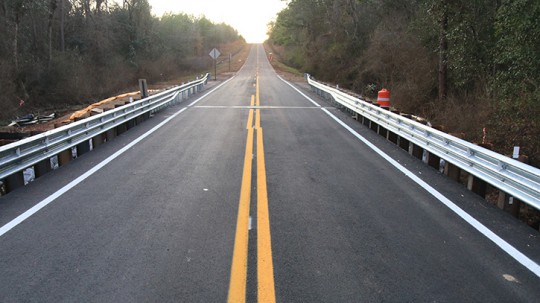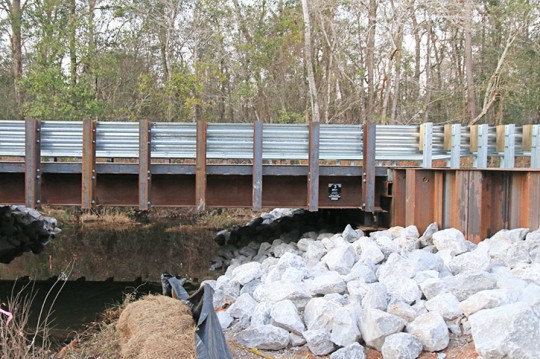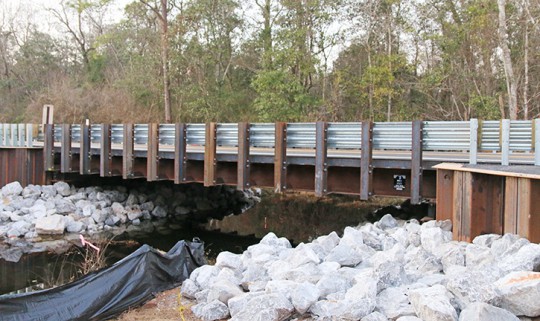Innovative Steel Bridge Opens On Arthur Brown Road In Walnut Hill
January 30, 2018
The Arthur Brown Road (Hwy. 99A) Bridge over Freeman Springs Branch has reopened after the full demolition and replacement of the previous bridge.
The Florida Department of Transportation ordered the closure of the bridge on November 8 after a failed inspection, and bridge replacement work began December 6 after the completion of preparatory requirements. The new 24-foot wide steel bridge arrived in three major pieces on January 5 and was installed on January 6.
Escambia County Administrator Jack Brown led the charge for the faster pre-fabricated steel replacement versus traditional concrete bridge due to the number of residents facing lengthy detours of many miles.
The steel bridge saved several months of construction time and cost about $400,000 as opposed to $1 million for a concrete bridge.
“I believe this is a great example of the County Administrator Jack Brown understanding that we needed some alternative methods of working both quickly and less expensively,” District 5 Commissioner Steven Barry said. “Additionally, I am very excited for the residents and those who commute through the affected area”
County officials have said they hope to use more of the steel bridges on future county funded bridge replacements.
Eight other North Escambia bridges remained closed for replacement construction.
“I understand many residents are still inconvenienced by the many bridge closures, and I am diligently working to get all the bridges open as quickly as is safely possible,” Barry said.
To read more about the steel replacement bridge and see additional photos, click here for an earlier article “Escambia County Explores How To Build A Bridge Faster, Smarter And Cheaper“.
Pictured: The Arthur Brown Road bridge over Freeman Springs Branch reopened Monday. NorthEscambia.com photos, click to enlarge.
Comments
4 Responses to “Innovative Steel Bridge Opens On Arthur Brown Road In Walnut Hill”







“How about all that unpainted steel…”
It’s called Cor-Ten or weathering steel. It never needs painting. It will rust a little at first and that layer of oxidation acts as a protective finish.
You owe the design team an apology.
How about all that unpainted steel that it’s constructed out of? Who’s genius
Plan was it to save a few hundred dollars on paint? Has no one ever heard of rust?
While everybody is patting each other on the back about savings and speed of installation, I still have a major problem with not raising the approach road bed by about three feet with a gradual raising of the bridge platform. Look at the clearance for flood waters to go through that narrow and low bridge. I have seen a bridge deck travel a quarter of a mile in a flood because they set the bridge too low. Our 100 year rains which are hitting the area with increased frequency, requires when setting these new steel bridges to do some raising of the bridge platform and roadway leading to the bridge. The steel pilings can easily be set three feet higher on the bridge walls without spending a dime more, but there will have to be fill and some paving to raise these bridges to handle a monster flood. Putting in low bridges without increased flow through is a formula for an expensive lesson. Penny wise pound foolish.
From the previous article linked to this story I wonder about this:
“We can’t use these metal span bridges on FDOT funded projects,” Brown said. “But we can look at the costs benefits on county projects that we fund.”
I wonder why some projects are paid by FDOT and some the county. I also wonder why district five is in emergency mode on these bridges.
In some ways I applaud the efforts to think out of the box and to save time *If the quality of the replacement is up to standards.
Does FDOT approve these? Why if FDOT pays for the project they don’t use these bridges?
How long will these last compared to concrete bridges?